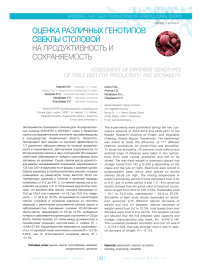Assessment of different genotypes of table beet for productivity and storability
Автор: Amirov B.M., Amirova Z.S., Manabaeva U.A., Zhasybaeva K.R.
Журнал: Овощи России @vegetables
Рубрика: Селекция и семеноводство сельскохозяйственных растений
Статья в выпуске: 4 (37), 2017 года.
Бесплатный доступ
The experiments were performed during the two successive seasons of 2015-2016 and 2016-2017 at the Kazakh Research Institute of Potato and Vegetable Growing, Almaty Region, Kazakhstan. The experiment was aimed to study the efficiency of 117 different beetroot accessions for productivity and storability. To study the storability, 20 beetroot roots without any external sings of diseases were taken in two replications from each variety accession and left to be stored. The wet fresh weight of beetroots placed into storage varied from 132 g to 320 g depending on the shape and the size of roots. Beetroots were stored in polypropylene bags, which were placed on barred shelves 30-35 cm high. The storing temperature in autumn and spring period of time fluctuated from 3-5o to 6-8°, but in winter period it was 1-2°. The observed results showed that the gross yield of beetroot accessions ranged from 25.0 to 105.4 t/ha, marketable yield - 16.7 to 74.9 t/ha, marketability - 33.8 to 97.2%. Storability of beet roots mostly depended on accession genotype with different natural decrease of weight and root rot diseases. Natural decrease of weight varied from 0.0 to 12.3%, total losses from root diseases were from 0.0 to 90.0%. The analysis carried out showed that the link between yield capacity and storage characteristics was weak, R= -0,042-0,144. The correlation between storability and root rot was R = -0,516-0,644, that was stronger than it was in natural decrease of weight, R = -0.115.
Assessment, beetroot, accession, breeding, productivity, storability
Короткий адрес: https://sciup.org/140205255
IDR: 140205255
Список литературы Assessment of different genotypes of table beet for productivity and storability
- The Committee of Statistics of the Ministry of National Economy of the Republic of Kazakhstan. 2015. 3 Series. Agriculture, forestry and fisheries. Gross harvest of agricultural crops in the Republic of Kazakhstan for 2015. Astana. 2015. -P 52-70.
- The State Register of Breeding Achievements Approved for Use in the Republic of Kazakhstan. Astana. 2016. -119 p.
- Abawi, G. S., Crosier, D. C., and Becker, R. F. Symptomatology and etiology of root rot of table beets in NewYork. Phytopathology, 1974. #63.-P:199.
- Martin, S. B., Abawi, G. S., and Hoch, H. C. Influence of the antagonist Laetisariaarvalison infection of table beets by Phomabetae. Phytopathology, 1984. -#74. -P.1092-1096.
- Whilney, E.D. and Duffus, I.E. Compendium of Beet Disease and Insects.APS Press, St Paul, Minnesota, USA, 1986.-76 p.
- Hoch, H. C., and Abawi, G. S. Biological control of Pythium root rot of table beet with Corticium sp. Phytopathology, 1979.-#69. -P. 417-419.
- Hanson, L. E. Interaction of Rhizoctonia solani and Rhizopussiolonifer causing root rot of sugar beet. Plant Dis. 2010.-#94. -P. 504-509.
- Klotz, K.L. and L.G. Campbell. Effects of Aphanomyces root rot on carbohydrate impurities and sucrose extractability in postharvest sugar beet. Plant Disease, 2009. -#93 (1). -P. 94-99.
- Campbell, L.G., K.K. Fugate and W.S. Niehaus. Fusarium yellows affects postharvest respi-ration rate, sucrose concentration and invert sugar in sugarbeet. Journal of Sugar Beet Research, 2011.-#48 (1-2). -P. 1740.
- Olsson, R. Sustainable harvest and storage of sugar beets -more beet and more sugar to the factory -variety and storage 2010-2011. NBR, 2011. -Report 611 -2010-2011. -34 pp.
- Kenter, C. & C. Hoffmann. Changes in the processing quality of sugar beet {Beta vulgaris L) during long-term storage under controlled conditions. International Journal of Food Science & Technology, 2009. -#44 (5). -P. 910917.


